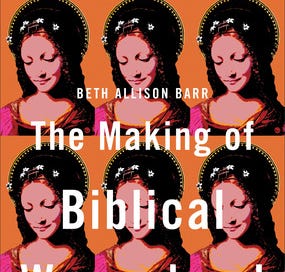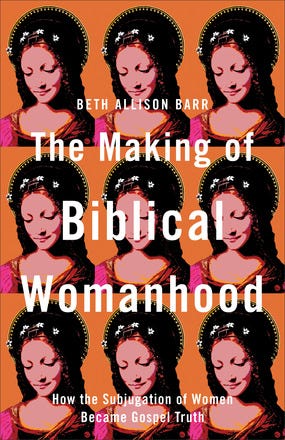The Making of Biblical Womanhood by Beth Alison Barr
Reviewed by Alexis Bird
The Making of Biblical Womanhood: How the Subjugation of Women Became Gospel Truth published by Brazos Press early this year (2021) details medieval historian Beth Allison Barr’s investigation into the cultural construction of modern American complementarian and how much rhetoric espoused by pro-complementarian groups relies upon a mythologized past of God-instituted female submission and male domination.
When I read this book, I greatly misunderstood what it was trying to achieve; I looked for a biblical defence of egalitarianism, a criticism of complementarianism evidenced by solid exegesis. Instead, I found myself reading Barr’s journey from a complementarian to an egalitarian, and the historical evidence which led her to believe that the image of womanhood taught in the church did not jump from the pages of the Bible but emerged from patriarchal values.
This book’s emphasis is historical, not theological, evidence; it highlights how women have taught, preached, and led Christian movements. These stories evidence that submissive womanhood was not a historic constant interrupted by the godless feminists. Barr’s women come from many Christian traditions, and she discusses that they were active in the church, not what they taught. I found this frustrating at points. Some of the women are theologically contentious; Ellen G White, a key figure of the historical Seventh Day Adventist Church, is briefly mentioned to illustrate Barr’s point. The problem is that complementarians could use this as grounds to discredit both the book and what happens when women are given a platform. Barr nowhere indicates that women themselves are infallible, instead, she uses historical evidence to subvert the assumption that women have always been passive in the church, that feminism perverts God’s design, and that any disavowal of complementarianism abandons the doctrine of inerrancy and bows to a radical, godless, feminist ideology. Barr reveals that women have been preachers, teachers, deacons, elders, and more prior to the inception of feminism.
Barr offers stories of women from the early church to the modern day to illustrate that the silent, submissive woman is not a traditional archetype towards which all godly women must aspire. Interspersed with narratives of woman martyrs, scholars, and preachers are her own experiences. We follow her hurt and determination as she and her husband are evicted from their church for daring to question theological complementarianism. Through this, she discusses the harm which this deep-seated ideology does to the church and the individuals therein: the sex scandals, the smothered voices, the abuse, the isolation.
In addition, Barr observes that although many complementarian churches claim that complementarian gender roles are radically counter-cultural, they in fact actualize pagan and secular expressions of patriarchy found in the surrounding culture. The Roman patriarchal model which removed women from political and economic engagement makes a reappearance in complementarianism. According to Barr ‘instead of assuming that patriarchy is instituted by God, we must ask whether [it] is a product of sinful human hands’ (25).
Barr makes a radical claim in chapter 2: that our theology of women in the church should not come from Paul, or at least not just from Paul. There are notable women throughout the Bible who do not conform to the few Pauline verses whipped out by frothing complementarians. Even the Pauline women do not conform to the popular interpretation of key passages. Evidently, a more nuanced understanding of women and their ecclesial role is necessary. We must read Paul in light of, not in spite of, these women. Attempting to conform the Bible to our ideas of what it ought to say is dangerous territory; the Junia/Junias mistranslation and the Eternal Subordination Heresy are evidence of this. We must, Barr emphasizes, read the Bible holistically and not try to conform it to our (cultural) expectations.
She follows this with a criticism of the reformation. Post-Luther the ‘godly woman’ transformed from devoted virgin (or nun) to submissive wife and homemaker. This increased women’s economic dependence on their husbands and curtailed opportunities outside the domestic sphere. It aligned the genders as spiritually equal, but functionally, women were the dutiful side-kicks to male agents. Alfred to their Batman. Rather than serving their communities and churches, they served their husbands and children behind closed doors.
The historical insights offered by Barr was intriguing and supported my understanding of women as deacons and apostles in the early church. Women's participation in church leadership did not die after 100 AD and only later re-emerge with feminism. Rather, there is an uninterrupted historical and theological precedent for women as teachers and preachers in the church.
Occasionally the historic approach felt like a fallacious appeal to tradition, the very appeal which conservative churches will themselves make: hence why we must understand the concept of this book. Barr does not claim that because women have preached that it is good, but that because women have always been outspoken advocates for the gospel, that the cultural myth of historic complementarianism upon which conservative churches rely is just that- a myth. Barr writes that ‘glorifying the past because we like that story better isn’t history; its propaganda,’ (107). This is the thesis of the book. The historical approach reveals cultural complementarian propaganda as a constructed mythos of gender roles that does not reflect what we see in church history or the bible. And it needs to be reexamined.
I was reminded of an infamous line that Voddie Baucham delivered in a sermon on women in the church. Turning to 1 Timothy 2 he reads the passage before proclaiming: ‘The Bible says it. I believe it. That settles it.’ He emphatically slams the bible shut. Conversation over. The crowd cheers.
This is a caricature of complementarianism, but the ethos behind that statement is what Barr addresses; the belief that the simple reading is the inerrant one, that tradition supports these claims, and to depart from it is to depart from orthodoxy. Through this book, Barr draws attention to the cultural-historical construction of biblical womanhood; she asks the reader to consider the validity of these claims and to follow the biblical, rather than a cultural image of biblical womanhood.





I am always somewhat surprised, though less so now since I've seen it so much, that history is given such precedence in deciding a theological issue. To me, the bible is the final authority. If it is shown to say something, that is the end of the discussion as far as I am concerned. So the debate needs to be in the interpretation of the texts.
From what I have seen, the egalitarians have not made a good case that the bible teaches what they claim. Are there passages misinterpreted by complementarians? Sure. At least in my view. I still don't see a truly cohesive and well argued case for full egalitarianism. I also do not see nearly as much as some complementarians see in terms of gender restrictions. I do think it is clear though that men are to lead in the home and that men are to be the elders in a church. I see the weight of the evidence as too great to be gotten around.
I think Barr's observation that Complementarians aren't as counter-cultural as they would like to think are spot on.